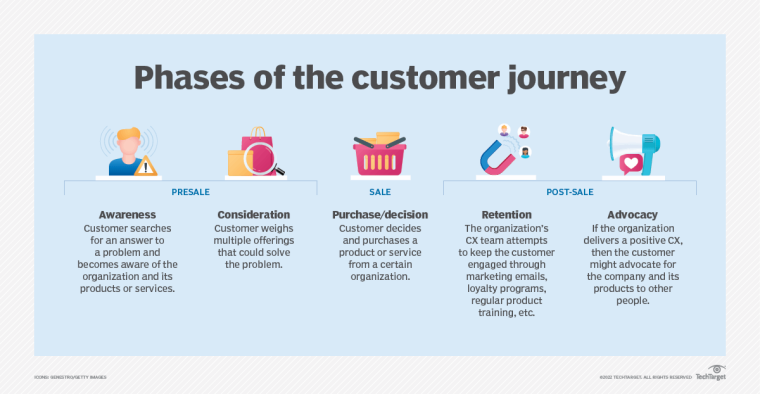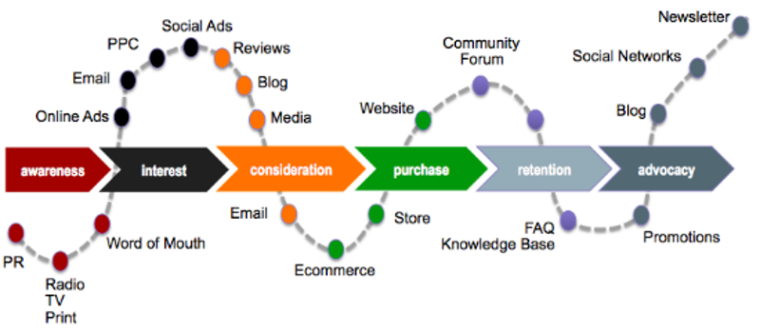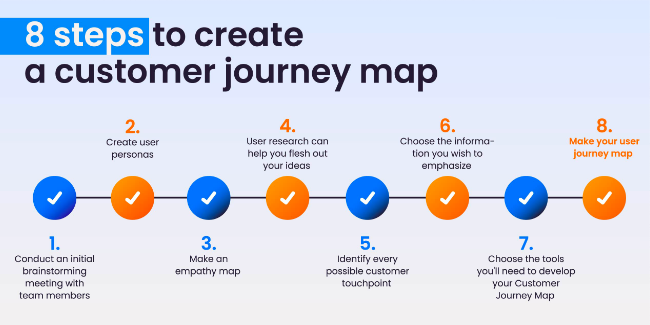In today’s rapidly evolving digital landscape, understanding your customers’ journey is paramount for business success. The digital customer journey serves as a roadmap, guiding you through every touchpoint a customer encounters on their way to making a purchase or engaging with your brand.
Digital customer journey mapping, an insightful tool in modern business strategy, provides an intricate visualization of this journey, offering a deeper understanding of customer behavior and preferences. In this article, we’ll delve into the essence of digital customer journey mapping, and its significance, and exemplify its application through real-world examples.
Key Takeaways:
- Mapping offers a strategic view of customer interactions across digital channels.
- Break the journey into phases – awareness, consideration, purchase, retention, and advocacy.
- Use insights to personalize experiences and increase engagement.
- Address pain points to improve satisfaction and boost conversions.
- Regularly monitor data, gather feedback, and refine strategies for ongoing success.
What Is the Digital Customer Journey?
The digital customer journey is the complete path that a customer follows while interacting with a brand through online channels. It encompasses every touchpoint, emotion, and interaction customer experiences, from initial awareness to eventual conversion and beyond.
Digital customer journey mapping visualizes and analyzes this journey, highlighting touchpoints, emotions, and interactions to uncover pain points and opportunities for optimization. Understanding the digital customer journey is crucial for crafting a seamless and personalized customer experience, which can lead to increased engagement, conversions, and brand loyalty in today’s digitally driven landscape.
The Five Phases of the Digital Customer Journey:
The digital customer journey can be divided into five distinct phases, each representing a key interaction point between the customer and the brand:
1. Awareness:
In this initial phase, potential customers become acquainted with your brand’s existence. This awareness can stem from various sources such as social media, online ads, search engine results, or word-of-mouth. It’s during this phase that the first impression is formed. Brands need to ensure that their online presence is impactful and aligned with their core values to capture the attention of potential customers.
2. Consideration:
Once a customer is aware of your brand, they enter the consideration phase. Here, they start evaluating your offerings against alternatives. They may read reviews, compare prices, and delve deeper into your website’s content to make an informed decision. The consideration phase is where customers seek valuable information and assurance that your product or service meets their needs.
3. Purchase:
The purchase phase is the culmination of the decision-making process. After careful consideration, the customer decides to make a purchase. This phase involves the actual transaction, where the customer navigates through your website’s purchasing process. A seamless and user-friendly checkout process is essential to prevent any obstacles that could deter customers from completing their purchases.
4. Retention:
Once the purchase is made, the focus shifts to retaining the customer’s interest and engagement. Businesses need to maintain a positive post-purchase experience to encourage repeat business. This phase involves effective communication, personalized recommendations, and exceptional customer support. Satisfied customers are more likely to return for future purchases and become loyal advocates for your brand.
5. Advocacy:
The final phase of the digital customer journey is advocacy. Delighted customers who have had positive experiences are inclined to share their satisfaction with others. They become brand advocates, spreading positive word-of-mouth through social media, reviews, and referrals. Advocacy not only increases brand visibility but also instills trust in potential customers who value peer recommendations.
Why Is Digital Customer Journey Mapping Important?
Mapping the digital customer journey has emerged as a critical tool for businesses in today’s fast-paced world. It’s like having a treasure map that leads to understanding customers better, and this understanding is like gold for businesses. Let’s dive into why this mapping is so important.
- Unveiling Customer Behavior Insights:
Imagine having a magical pair of glasses that lets you see exactly what your customers are doing online. That’s what digital customer journey mapping does, but even better! It shows where customers go, what they click on, and what makes them smile or frown. This helps businesses understand why customers do what they do. For instance, it reveals if customers get confused while shopping or if they like certain parts of the website more. With these insights, businesses can figure out what works and what doesn’t, just like a chef perfecting a recipe.
- Crafting an Amazing Customer Experience:
Imagine you’re at a theme park, and every ride and show is tailored just for you, making you feel super special. That’s what businesses aim for with customer experience, and digital customer journey mapping is the secret ingredient. By knowing where customers are on their journey, businesses can create personalized experiences. They can suggest products related to what customers are interested in or remind them of items they left in their online carts. It’s like having a personal shopping assistant guiding you through a store.
- Boosting Sales and Engagement:
Picture this: a store where everything is placed exactly where you’d like it, making you want to buy more. That’s the goal of digital customer journey mapping. When businesses understand the journey, they can design their websites to make shopping super easy and enjoyable. This can encourage customers to buy more things. Moreover, when customers have a great time on a website, they stay longer, explore more, and might even tell their friends about it. This boosts engagement and spreads the word about the business.
- Making Smarter Business Moves:
Think of digital customer journey mapping as a crystal ball that helps predict the future – well, almost! By knowing what customers like and dislike, businesses can plan ahead. They can launch new products or features that customers are likely to love. It’s like a chess game where they know the next move of their customers. This saves time, money, and effort that would otherwise be spent on things customers wouldn’t really care about.
Examples of Digital Customer Journey Mapping

Now that we understand the importance of digital customer journey mapping, let’s delve into comprehensive examples that illustrate distinct phases of the journey can be optimized. These examples will showcase real-world scenarios, providing insights into practical applications of digital customer journey mapping.
1. Online Banking Platform
- Awareness Phase Optimization: An online banking platform utilizes targeted Facebook and Google ads to reach users searching for digital financial solutions, showcasing their advanced security measures and user-friendly interfaces.
- Consideration Phase Optimization: The platform offers informative webinars and comparison charts detailing the benefits of various account types. Their website provides a live chat feature for immediate customer assistance.
- Purchase Phase Enhancement: The account signup process is streamlined with clear steps and options for document upload. Users can choose from multiple secure payment methods, enhancing convenience.
- Retention Phase Strategy: After signup, personalized financial advice based on transaction history is sent via email. Users who make regular transactions are enrolled in a rewards program that grants access to exclusive features.
- Advocacy Phase Nurture: Satisfied users are encouraged to share their experiences on social media, leveraging a referral program to reward both advocates and new customers.
2. E-commerce Fashion Retailer
- Awareness Phase Optimization: A fashion retailer collaborates with influential fashion bloggers, sharing trendy outfit ideas and exclusive discount codes via Instagram and YouTube.
- Consideration Phase Optimization: On their website, a virtual fitting room technology lets customers “try on” clothes digitally. Product pages feature detailed size guides, real customer photos, and live chat support.
- Purchase Phase Enhancement: The checkout process is optimized with autofill options and a clear progress bar. Shipping options, delivery times, and return policies are explicitly and clearly stated.
- Retention Phase Strategy: Customers receive tailored style recommendations based on their past purchases, and loyalty members enjoy priority access to limited-time sales and new collections.
- Advocacy Phase Nurture: A social media hashtag campaign encourages customers to share their styled outfits, and a loyalty program rewards points for every social media share that results in a new customer.
3. Health and Fitness App
- Awareness Phase Optimization: A fitness app partners with fitness influencers, who post before-and-after photos on social media, showcasing their transformations using the app’s workout plans and nutrition guides.
- Consideration Phase Optimization: Prospective users can access a free trial with limited features. Upon signing up, the app’s AI suggests personalized workout routines and meal plans based on user goals.
- Purchase Phase Enhancement: Subscribing is made easy through a mobile-friendly interface, offering monthly, quarterly, and annual options. Users are informed about the app’s features through a series of interactive onboarding screens.
- Retention Phase Strategy: Users receive daily motivational messages and progress tracking. Community challenges and forums provide opportunities for users to connect and share their achievements.
- Advocacy Phase Nurture: Successful users are encouraged to post their progress on social media, tagging the app’s official account. Referral incentives offer free months of premium access for every friend referred.
These real-world scenarios showcase how businesses can apply digital customer journey mapping to optimize various phases of the customer journey, leading to improved user experiences and achieving business goals.
How to Start Digital Customer Journey Mapping

Embarking on the journey of digital customer journey mapping requires a systematic approach to gain comprehensive insights into your customers’ interactions and experiences. Below are the essential steps to consider when beginning digital customer journey mapping for your business, along with explanations for their significance:
1. Identify Goals:
Clearly define the objectives you intend to achieve through the mapping process. Whether it’s improving customer satisfaction, increasing conversions, or reducing churn, having specific goals will guide your mapping efforts.
Setting clear goals provides direction and ensures that your mapping efforts are aligned with your business objectives. It helps you focus on the areas of the customer journey that are most relevant to your desired outcomes.
2. Collect Data:
Gather data from various touchpoints along the customer journey. This could include website analytics, social media interactions, customer feedback, surveys, and any other relevant sources.
Data collection forms the foundation of accurate customer journey mapping. It provides insights into customer behavior, preferences, pain points, and engagement levels. The data collected enables you to create a realistic and data-driven representation of the journey.
3. Create Personas:
Develop detailed customer personas that represent different segments of your target audience. These personas help you understand the diverse needs, preferences, and behaviors of your customers.
Personas add depth to your mapping process by allowing you to visualize the journey from the perspective of various customer segments. This understanding is crucial for tailoring experiences that resonate with different types of customers.
4. Map the Journey:
Create a visual representation of the customer journey, detailing each phase and touchpoint. Include emotions, interactions, pain points, and key milestones in the journey.
Mapping the journey visually helps you identify gaps, opportunities, and potential bottlenecks. It provides a holistic view of the customer experience, allowing you to pinpoint areas that need improvement.
5. Identify Pain Points and Opportunities:
Analyze the mapped journey to identify pain points where customers might face challenges or frustrations, as well as opportunities for enhancing the experience.
Recognizing pain points is essential for addressing customer grievances and preventing churn. Identifying opportunities helps you focus your efforts on creating positive interactions that lead to customer delight and loyalty.
6. Prioritize Improvements:
Prioritize the identified pain points and opportunities based on their impact and feasibility. Focus on changes that will have the most significant positive impact on the customer experience.
Prioritization ensures that your resources are utilized efficiently. It allows you to address critical issues first and gradually work towards enhancing the entire journey.
7. Implement Changes:
Implement the necessary changes based on the prioritized list. This could involve optimizing website interfaces, refining communication strategies, or enhancing the checkout process, among others.
Implementation is where your mapping efforts translate into tangible improvements. Taking action based on insights gained from the mapping process ensures that you’re actively working towards a better customer experience.
8. Monitor and Iterate:
Your site will never be absolutely perfect and will always need regular iteration to ensure you get the most out of it. Continuously monitor the effects of your changes using relevant metrics. Gather feedback from customers and stakeholders to ensure that the implemented improvements align with their expectations.
Monitoring and iterating allow you to measure the success of your optimization efforts. It also enables you to adapt to changing customer preferences and market dynamics, ensuring that your customer journey remains relevant over time.
How to Derive Valuable Insights From a Digital Customer Journey Map
Creating a digital customer journey map is only the first step; the real value lies in extracting actionable insights from the map to improve your website and business. Here’s how you can use your map to gain valuable insights and effectively enhance your customer experience:
- Spot Pain Points: Identify points of friction or challenges that customers encounter during their journey. These pain points could include confusing navigation, slow loading times, or complex checkout processes. By addressing these issues, you can streamline the experience, reduce customer frustration, and increase the likelihood of successful conversions.
- Optimize Key Touchpoints: Focus on optimizing crucial touchpoints where customers make decisions or engage with your brands, such as the homepage, product pages, and checkout process. Based on your map, ensure that these touchpoints provide clear information, compelling calls-to-action, and user-friendly interfaces to guide customers smoothly toward their goals.
- Personalize Experiences: Use insights from the map to tailor experiences based on customer segments and personas. By understanding your customers’ preferences, behaviors, and pain points at different stages, you can deliver personalized content, recommendations, and offers that resonate with their needs and interests.
- Enhance User Flow: Analyze the customer journey flow to ensure it is intuitive and logical. Identify any unnecessary steps or detours that might hinder the smooth progression through the phases. Streamlining the user flow can lead to improved engagement, higher conversions, and reduced bounce rates.
- Test and Iterate: Utilize A/B testing and user feedback to validate the insights you’ve gained from your map. Experiment with different variations of elements such as CTAs, page layouts, or checkout processes to determine which changes have the most positive impact on customer behavior and satisfaction.
- Address Mobile Experience: Evaluate how your map reflects the mobile customer journey. With the increasing use of mobile devices, it’s essential to ensure that your website is responsive and offers a seamless experience across different screen sizes. Identify any mobile-specific pain points and optimize accordingly.
- Measure and Track Metrics: Leverage analytics tools to track key performance indicators (KPIs) related to your customer journey map. Monitor metrics such as bounce rates, conversion rates, average session duration, and click-through rates to assess the effectiveness of your optimizations.
- Foster Engagement and Advocacy: Leverage insights from the map to nurture customer engagement and advocacy. For instance, if you’ve identified that customers are most engaged after making a purchase, consider implementing post-purchase email sequences or loyalty programs to maintain that engagement and turn satisfied customers into advocates.
- Iterate Based on Feedback: Regularly gather feedback from customers through surveys, reviews, and social media interactions. Use this feedback to refine and adjust your map continuously. Customer input can offer valuable insights into aspects of the journey that may not be immediately apparent from data alone.
- Stay Updated: As customer behaviors and preferences evolve, keep your map up to date. Regularly revisit and adjust your map to reflect any changes in the digital landscape or your business offerings. This proactive approach ensures that your insights remain relevant and actionable.
Is Digital Customer Journey Mapping Essential for My Business?
In the ever-evolving digital landscape, understanding the digital customer journey is essential for online businesses of all sizes. E-commerce stores, subscription services, tech platforms, and any entity with an online presence can benefit significantly from this insightful tool. By aligning strategies with customer expectations, businesses can thrive in today’s competitive market, fostering loyalty and advocacy among their customers.
Digital customer journey mapping is a pivotal technique that unlocks a deep understanding of customer behavior and preferences in the digital realm. By comprehending each phase of the journey, businesses can optimize touchpoints, enhance customer experiences, and drive growth. With the right approach, digital customer journey mapping becomes a compass that guides businesses towards success in the dynamic world of digital commerce.